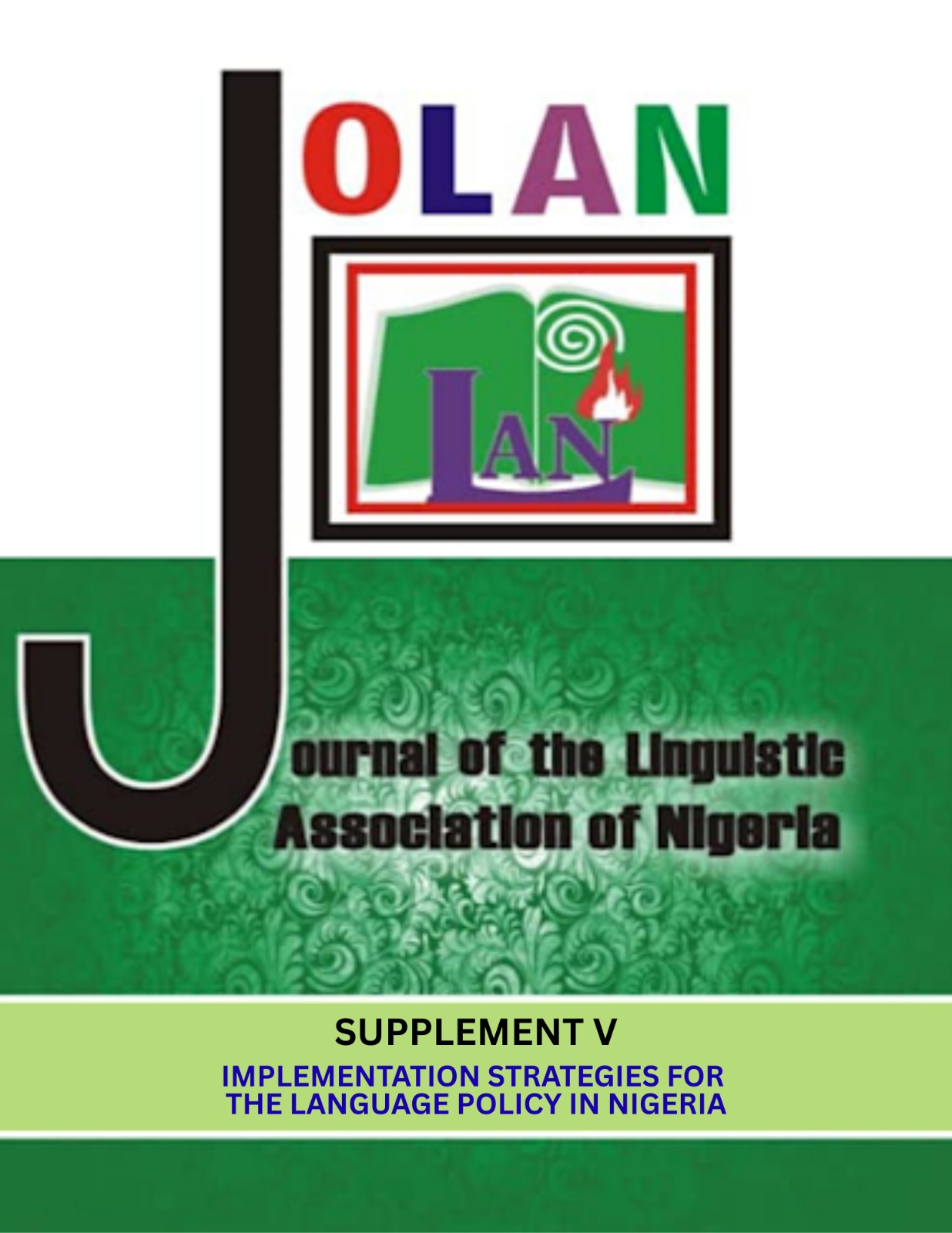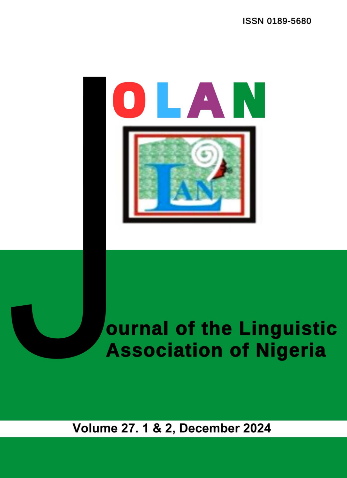The study of suffixation in Waja language plural formation
DOI:
https://doi.org/10.60787/jolan.vol5no1.412Keywords:
Documentation, pluralisation, suffixes, morphology, plural marker, affixes, derivationAbstract
This paper investigates and describes the process of suffixation in plural formation in Waja, a language spoken predominantly in Balanga Local Government Area of Gombe State. Languages may form plurals through different inflectional or derivational strategies; in Waja, plural formation largely occurs through suffixation. The study adopts a descriptive approach to data analysis, drawing insights from Nida’s (1985) principles of descriptive linguistics. The research identifies nine plural markers used in suffixation processes in Waja: -i, -ni, -di, -ri, -wa, -ba, -ma, -ndi, and -ngi. These markers occur as affixes in the language, typically with nouns and, to a lesser extent, adjectives. Examples include: bàkόrὸ
‘donkey’ → bàkόrí ‘donkeys’ (-i marker); gόnò ‘ant’ → gὸní ‘ants’ (-i marker); msâm ‘lion’ → msâmdí ‘lions’ (-di marker); nyàngí ‘monkey’ → nyandí ‘monkeys’ (-ndi marker); prá ‘question’ → prândí ‘questions’ (-ndi marker); lѐe ‘answer’ → lѐndí ‘answers’ (-ndi marker); bàfátὸ ‘tiger’ → bàfátùní ‘tigers’ (-ni marker). The study further observes that some markers - particularly -i, -di, -ndi, and -ngi - are more productive than others. In conclusion, the paper recommends further research into pluralization processes in Waja, with a focus on productivity and distribution patterns of plural markers.
References
Albirini, A. (2014). Concatenative and Nonconcatenative plural Formation in L1, L2, and Heritage Speakers of Arabic. Modern Language Journal. Vol. 98 Issue 3, P854-871. 18p. 1 diagram, 12 charts, 1 graph
Aliyu, A. (2013). Waja-English-Hausa Dictionary. B.A Project. Department of Languages and Linguistics, University of Maiduguri.
Binder, C. (2014). Plural Identities and Preference Formation. Social Choice & Welfare Journal. Vol. 42Issue 4, P959-976. 18p.
Franz, J. (2020). Plural Formation in English and German, Munich, GRIN Verlag. https://ww.grin.com/document/899498
Lieber, R. (2009). Introducing Morphology. Cambridge: Cambridge University Press.
Mathews, P. H. (1993). Morphology. An Introduction to the Theory of Word Formation. London: Cambridge University Press.
Moro, F. R. (2018). The Plural Word Hire in Alorese Language: Contact-Induced Change from Neighboring Alor-Pantar Languages. Oceanic Linguistics. Vol. 57 Issue 1, P177-198.22p.
Mukoshy, I. A. (1978). A look at Hausa Plurals. In Ibrahim Yaro Yahaya and Abba Rufa’i (Eds.) Study of Hausa Language, Literature and Culture Proceedings of the Hausa International Conference. C.S.N.L. Bayero University, Kano. PP. Vol. 1
Mustapha. A and Salihu. H (2020). A Review of Plural Formation on Fulfulde Nouns. Nigerian Journal of African Studies, Vol. 2. No 1. pp 34-47
Næss, Å. (2018). Plural-Marking Strategies In Äiwoo.Oceanic Linguistics. Vol. 57 Issue 1, P31-62. 32p.
Nida, E. A. (1952). Morphology: The Descriptive Analysis of Words. Second Edition. Lithoprinted in the United State of America by Cushing-Malling. INC, Ann Arbor, Michigan.
Offiong, O. A. (2011). Efik Morphological Process. I.WATI: A Journal of Contemporary Research, 86-98
Salim, B. A. (1981). Linguistic Barrowing as External Evidence in Phonology: The Assimilation of English Loan Words in Hausa. Unpublished Ph.D. Dissertation. University of New York.
Salim, J. A. (2013). A contrastive Study of English-Arabic Noun Morphology. International Journal of English Linguistics: 3(3), 122-132.
Smith, J.(2018). The First-Person Plural and Immunity to Error Disputatio: International Journal of Philosophy. Vol. 10 Issue 49, P141-167. 27p.
Umar, A. (2023). A Study of Reduplication in the Basa Language. Unpublished Ph.D Dissertation, Department of Linguistics and Foreign Languages, Bayero University, Kano.
Wiese, R. (2001). Grammar and Typology of Plural Noun Inflection in Varieties of Germa. Journal of Comparative Germanic Linguistics. Vol. 12 Issue 2, p137-173. 37p. 25 Charts.
Zeki, H. (2011). Morphology in English: Word Formation in Cognitive Grammar. London: Continum.
Downloads
Published
How to Cite
Issue
Section
License
Copyright (c) 2025 Journal of The Linguistic Association of Nigeria

This work is licensed under a Creative Commons Attribution-NonCommercial-ShareAlike 4.0 International License.














